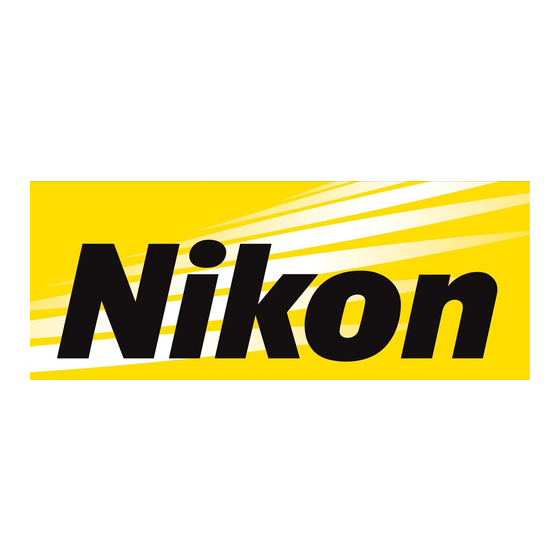
Subscribe to Our Youtube Channel
Summary of Contents for Nikon Live Cell 2
- Page 1 Nikon King’s College London Imaging Centre Live Cell 2 guide NIKON IMAGING CENTRE @ KING’S COLLEGE LONDON...
- Page 2 60x and 100x objectives can be added to the system but are not permanently installed. sCMOS (monochrome) camera Colour camera Fig. 1 Fig. 2 Microscope Switch Do not switch off Fig. 3 Fig. 4 Nikon Imaging Centre @ King’s College London...
- Page 3 Nikon King’s College London Imaging Centre Condenser element selector Objective selector Intensity Light path dial Transmitted light on/off Fig. 6 Fig. 5 Epi-fluorescence filter turret on/off z-speed Epi-fluorescence shutter Fig. 7 Fig. 8 Nikon Imaging Centre @ King’s College London...
- Page 4 , the valve on the tank needs to be adjusted to ensure that it is entering the system correctly: open the top valve on the CO bottle (anticlockwise), then turn the regulator knob (clockwise) to achieve a pressure of ̴ 0 .3 bar. Fig. 10 Fig. 1 Nikon Imaging Centre @ King’s College London...
- Page 5 Nikon King’s College London Imaging Centre Fig. 12 Fig. 11 Press to set CO2 concentration Fig. 13 Nikon Imaging Centre @ King’s College London...
- Page 6 3. If required, centre the field iris in the eyepiece using the adjustment screws on the condenser unit. 4. Once centred, open the field iris again so that the field iris edges are just outside of the field of view. Nikon Imaging Centre @ King’s College London...
- Page 7 1 for objectives up to 20X, phase imaging 2 for the 40X, DIC for 60X and 100X and open for standard brightfield. Fig. 15 Fig. 16 Nikon Imaging Centre @ King’s College London...
-
Page 8: Image Acquisition
When starting Elements software the correct camera driver needs to be selected (note that it is possible to select both). After logging in it is possible to select the required driver from the dropdown menu: Nikon DS-Qi2 for Fig. 17 brightfield/fluorescence imaging, Nikon DS-U3 for colour imaging (e.g. -
Page 9: Channel Settings
For each channel select the optical configuration from the drop-down list, ordered so that the configurations go from longest wavelength to shortest. Press Run Now acquire the multichannel image. Nikon Imaging Centre @ King’s College London... - Page 10 (if PFS is used this can also be set in the same way). 3. The arrows, shown in red boxes in Fig. 25, are used to update stored positions. Fig. 25 Nikon Imaging Centre @ King’s College London...
- Page 11 Set your folder for saving and file name for the save option required. Fig. 26 7. Z-stacks may also be applied to the image as well as automatic refocusing throughout the acquisition. Once all options have been adjusted, click scan. Nikon Imaging Centre @ King’s College London...
- Page 12 (use the Z value as a guide) and click Top. Focus back through the sample to do the same for the bottom plane of the sample. Stop imaging to avoid sample bleaching. Fig. 28 Nikon Imaging Centre @ King’s College London...
-
Page 13: Saving Data
2. You can also reuse ND setup for keeping the same settings in the ND acquisition window. 3. When reusing settings check the Ti2 pad and the camera settings to ensure that they have been applied correctly. Fig. 30 Nikon Imaging Centre @ King’s College London... -
Page 14: Troubleshooting
7. Return any oil bottle or slide cleaner used to the image analysis room (shelf above the safe) 8. Dispose of any used tissue in the bins, slides in the sharps bin and clinical waste in the yellow bin in the TC room. Nikon Imaging Centre @ King’s College London...















Need help?
Do you have a question about the Live Cell 2 and is the answer not in the manual?
Questions and answers